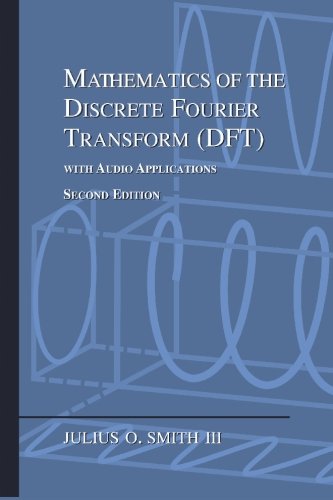
Mathematics Of The Discrete Fourier Transform (DFT) - With Audio Applications
Covers all about the Discrete Fourier Transform formula and its constituents, with frequent references to audio applications.
Tag(s): Signal Processing
Publication date: 13 Apr 2007
ISBN-10: 097456074X
ISBN-13: 978097456074
Paperback: 322 pages
Views: 28,637
Mathematics Of The Discrete Fourier Transform (DFT) - With Audio Applications
 Covers all about the Discrete Fourier Transform formula and its constituents, with frequent references to audio applications.
Covers all about the Discrete Fourier Transform formula and its constituents, with frequent references to audio applications.
Publication date: 13 Apr 2007
ISBN-10: 097456074X
ISBN-13: 978097456074
Paperback: 322 pages
Views: 28,637
Document Type: Textbook
Publisher: W3K Publishing
License: n/a
Post time: 11 Oct 2006 02:27:34
The Discrete Fourier Transform (DFT) can be understood as a numerical approximation to the Fourier Transform. However, the DFT has its own exact Fourier theory, which is the main focus of this book. The DFT is normally encountered in practice as the Fast Fourier Transform (FFT) -- a high-speed algorithm for computing the DFT. The FFT is used extensively in a wide range of digital signal processing applications, including spectrum analysis, high-speed convolution (linear filtering), filter banks, signal detection and estimation, system identification, audio compression (e.g., MPEG-II AAC), spectral modeling sound synthesis, and many other applications; some of these will be discussed in Chapter 8.
This book chooses to discuss DFT over the FT since the FT demands readers to use calculus right off the bat, while the DFT, on the other hand, replaces the infinite integral with a finite sum of various quantities. Calculus is not needed to define the DFT (or its inverse, as this book will show), and with finite summation limits, readers cannot encounter difficulties with infinities. Moreover, in the field of digital signal processing, signals and spectra are processed only in sampled form, so that the DFT is what readers really need anyway. In summary, the DFT is simpler mathematically, and more relevant computationally than the Fourier Transform. At the same time, the basic concepts are the same. Therefore, this book will begin with the DFT, and address FT-specific results in the appendices.
Intended Audience:
This book started out as a series of readers for an introductory course in digital audio signal processing that has been given at the Center for Computer Research in Music and Acoustics (CCRMA) since 1984. The course was created primarily for entering Music Ph.D. students in the Computer Based Music Theory program at CCRMA. As a result, the only prerequisite is a good high-school level algebra and trigonometry, some calculus, and prior exposure to complex numbers.
Tweet
About The Author(s)
Julius O. Smith III teaches a music signal-processing course sequence and supervises related research at the Center for Computer Research in Music and Acoustics (CCRMA). He is formally a professor of music and (by courtesy) electrical engineering at Stanford University. Prof. Smith is a Fellow of the Audio Engineering Society and the Acoustical Society of America. He is the author of four online books and numerous research publications in his field.

Julius O. Smith III teaches a music signal-processing course sequence and supervises related research at the Center for Computer Research in Music and Acoustics (CCRMA). He is formally a professor of music and (by courtesy) electrical engineering at Stanford University. Prof. Smith is a Fellow of the Audio Engineering Society and the Acoustical Society of America. He is the author of four online books and numerous research publications in his field.